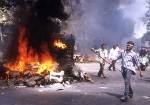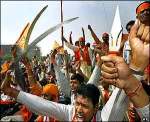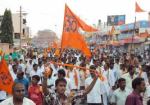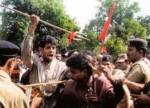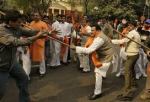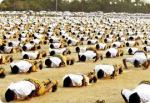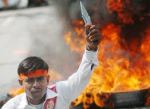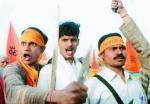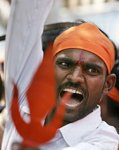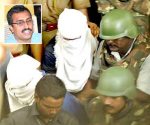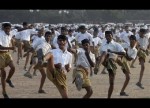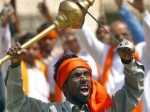Tagged: Tamil Nadu
Brahmin Terrorism Sample
Akhil Bharateeya Vidyarthi Parishad Terrorist attacked Meena Kandasamy
Example of Hindutva Terrorism,
Meena Kandasamy is the emerging face of Indian literature. She is from Chennai. She is basically a teacher and teaches college students about the nuances of poetry and literature. She is an established poetess now. Besides she is a social activist, writer, blogger, peace activist and a fine human beingwith a heart that beats. She likes to describe herself as a woman writer who is obsessed with revolutionary Dr.Ambedkar’s message of caste annihilation. Below it we present one of her article published in Boloji.com.
Doing It Everyday – 5
This denial of space in the mainstream, this marginalization is being exploited by the Sangh Parivar. For instance, reliable sources claim that the Akhil Bharateeya Vidyarthi Parishad Terror Cell (ABVP—the Students Wing of the Sangh Parivar Terrorism) has a large contingent of Dalit students, who are tempted into joining by the offer of ‘prestigious positions’ within that organization. Keeping an eye on future vote-banks and prospective card-carriers the RSS never makes a wrong move in its political expansion. Towards this end, icons of Dalit identity are systematically brought into the pale of saffron. For instance, in Coimbatore, on 10th July 2004, the RSS-ABVP Terrorist conducted an ‘Ekalavya 2004’ function to give free notebooks to poor Dalit students. Color photographs of Dr.Ambedkar adorn the covers of Vijaya Bharatam on April 14th. Remarking on this phenomenon, Teltumbde observes:
“The co-optation process started from the systematic inclusion of the greatest dalit icon-Babasaheb Ambedkar into the Sangh Pariwar icons. They made him Pratah Smaraniya and variously propagated as though he was a staunch Hindutva Terrorist. They started celebrating his birth anniversaries, organizing festivals and seminars; publishing books with systematic vision of saffronizing him. Although, they chose the day of his death anniversary for their infamous demolition of the Babri Masjid, they have been celebrating the demolition day with the images of Ram and Ambedkar placed alongside. For gullible dalit masses reared on symbolism by the degenerate post-Ambedkar dalit leadership, the cooptation of Ambedkar meant change in attitude of the Brahmin camp. If Ambedkar symbolized concern for dalits, Sangh Pariwar did not lack in resources in making exhibitionist demonstration of this concern. It helped certain eager dalit elites to cross over to the resource rich Sangh Pariwar. Although, dalit masses did not follow these opportunist dalit elites it certainly helped in softening the anti-dalit image of the Sangh Pariwar and at the same time blurring the dalit identity.”
The same has been true of the Tamil Nadu example too. Here the Sangh Parivar prides itself in its ability to fund movements led by Dalits who are made to speak of the need to return to Hindutva. Such disgruntled sections and breakaway minor leaders from a most-backward caste party or a Dalit party were immediately bestowed with BJP tickets to parliamentary elections: Two of the five BJP candidates contesting from Tamil Nadu in the 2004 General Elections had such a ‘deserter’ background. Though they had earlier been models of militancy and staunch opponents of Hindutva, position and the dream of power could change their perspective overnight.
But people aren’t as easily turn-coat as politicians, and overnight changes in the worldview cannot be incorporated into the masses. Their percolation into Dalit lives is slower, but nevertheless vigorous, as can be seen from the sudden spate of building separate temples in Dalit areas. This not only gives them new Gods to pray too, but also subverts the eradication of the remnant forms of untouchability. Estimates given by the VHP, peg this number of new temples at 120, but it is just the tip of the iceberg. All over Tamil Nadu, the actual number of made-by-Sangh-Parivar temples might be a hundred times more, for a temple is, more often than not an idol, holy ash and kumkum, and someone to attend to it on holy days.
We need to also mention here that such participation of dalits in Hindtuva rituals/ celebrations has done nothing to remove untouchability or casteist oppression and discriminaton. Caste crimes are as crude, and as stark as ever. This is because despite all the wooing of the Dalits, the Sangh Parivar always tacitly aligns with the oppressors. Its largest following and economic support are from the castes that have a history of oppressive and caste-supremacist behavior. In southern Tamil Nadu, the RSS-VHP-Hindu Munnani finds its mutual counterpart in the Thevar community dreaded for its claims of aggressive masculinity and caste supremacy. That is why Praveen Togadia planned to do a Trishul Diksha at Madurai during the birthday celebrations of Pasumpon Muthuramalinga Thevar organized by the Thevar Peravai. Similarly, Fuller notes that Maravars (another oppressor caste) had the maximum participation in the Vinayaka Chaturthi. This consolidation of caste-interests, also makes the Sangh Parivar a power block, giving the illusion of its being capable of swaying Hindu interests.
Wooing the Women
Like all movements of religious fundamentalism, the Sangh Parivar uses women as tools and makes them upholders of morality and decency. Their teachings implore women to understand the greatness of chastity and the need for unswerving loyalty to their family. The family here is the central agent of control, and women are required to adjust and not revolt against its authority. Women are portrayed as the custodians of culture and upholders of tradition—so, women’s liberation is to the Sangh a ghost of a riddle, an un-asked question that anyway requires no answers.
In the Tamil Nadu context, the Rashtriyasevika Samiti and the Sewa Bharati are the women wings of the saffron brigade. Here too, festivals are the key to mobilization of women. The report of the International Initiative for Justice on the Gujarat carnage notes:
“The Sangh Combine has strategically drawn in large numbers of women into its campaigns by using religious festivals as a focal point. From such innocuous beginnings, it has systematically incorporated women into its hate-filled mobilization against Muslims and has even distributed trishuls among them. Violence against women from Muslim communities was unprecedented during the Gujarat carnage and women from Hindu communities participated actively in the violence.”
The same thing has been happening in Tamil Nadu for the past two decades. I am not being portentous, although Gujarat has not yet been replicated, that day is not faraway in Tamil Nadu. Here is an excerpt from the book, RSS: A Vision in Action,
“[T]raditionally, Hindu women have been the repositories of piety and devotion. Tamilnadu VHP has made pioneering efforts in this respect and the response they are receiving is truly remarkable.”
Now the back-scratching is complete. The RSS publication praises the remarkable VHP. Drum-rolls please, before we proceed to read the pioneering efforts.
“During the freedom struggle, Mahakavi Subrahmanya Bharati made use of this tradition for rousing national consciousness among women. Now, VHP has picked up the thread. During Navarathri, 1,008 deepa-poojas are regularly organized throughout the state. The spontaneous response from women-folk can be gauged by the fact that in 1987, 148,645 ladies partook in 2,842 deepa-poojas in 243 places.”
Close to one and a half-lakh women had participated in such deepa poojas as early as in 1987. Imagine the numbers today, seventeen long years since then, with the Hindutva government at the centre, alliance with the ruling parties and other favorable circumstances. A similar festival is the paal-kudam (milk pot), where large numbers of women carry milk pots for the purpose of abhisekha to temples. The minimum number is 108, the maximum so far has been 1008. Such continued holding of Deepa Poojas (in Tamil they are called Thiruvilakku Poojas) gives the women the power to participate outside the domestic sphere. This entry into the public domain gains them additional respectability in their homes. Though women take active part in all the festivals, such unique, women-only festivals give them an enhanced sense of femininity and womanhood.
On the local level, women are consolidated using activities that require them to get together and meet often such as the bhajan mandalis. Also, the practice of observing fasts, is generally more incumbent on the women of the Sangh Parivar. Apart from the health and hygiene reasons to which they stake claim; fasting, is indicative of moving towards purity, towards an ideal of self-control and sense-control. Such an emphasis on the elimination of craving and desire, aids in their project of the complete desexualization of women. They are wrapped up in protectionist discourses. Only the reproductive role is stressed time and again: matri-shakti underlines the womb: there is a control over the bodies for the project of begetting proud and valiant sons for the Hindu Rashtra.
The introduction of festivals like Raksha Bandhan into a state that had never heard of the custom, let alone practiced it, pinpoints the role of the Sangh Parivar in transforming an upper-caste North Indian tradition into a universal celebration. The fact that it is one of the six-recognized celebrations of the RSS highlights its importance in their agenda of Hindu Rashtra. (Unfortunately for the Sangh, the introduction of the Rakhi culture, results in much hilarity. Popular girls buy rakhis by the dozen, which they tie to the hands of interested men whom they want to keep at bay. A simple piece of thread can transform prospective boyfriend into protective brother, a kind of magic that can otherwise never be achieved.) In the larger, real picture it seems a grim, painful tradition because it projects women as people who need protection.
Throughout the ideology of the Sangh, we find this constant reiteration that women, like children are weak people. So the patriarchy of the Parivar romps home with its protectionist policies. Perhaps this is aimed at according a greater masculinity to the men of the Sangh.
Children are enticed into the Sangh Parivar by the tinkering of the syllabus and the tarnishing of fresh minds. Schools run by the Hindutva forces are made to observe religious functions and rituals, students are made to stage patriotic (read Hindutva) plays.
One also needs to look at the maintenance of separate identities for women: they are generally not included in the masculine Vinayaka Chaturthi processions but in the ultra-feminine paal kudam, the deepa poojas, the fasting, the bhajan mandalis. Nothing that will affect her, nothing that will allow her to assert herself, or even assert her body. This perhaps arises out of the very low opinion of women that the reactionary Parivar holds. As an example, the then Deputy Chief Minister of Rajasthan, Hari Shankar Bhabra is reported to have said, ‘Why talk of humans, even gods cannot be sure of woman’s character.’
If ideology can take the Sangh Parivar thus far, crucially cunning strategies can take them farther. Their newest targets are the Self-Help Groups (SHGs) run by women. In July 2004, 5000 women marched the streets of Coimbatore city under the banner of the Seva Bharati. All these women belonged to Self-Help Groups and are economically powerful, as well as being socially well connected. In 2003, 30,000 women running SHGs participated in an RSS function arranged for them at Kanyakumari. Apart from such consolidation of women with social awareness, the orange order reaches out to the simple womenfolk too through rath-yatras. In Tamil Nadu, it is not the powerful Durga Vahini that woos the women, but softer icons of patriarchy like Sharada Ma and the Mother of Pondicherry Ashram.
Now we have seen how the Dalits and women are being enticed into entering the Sangh Parivar in the Tamil Nadu context. Such a massive project of Hindutvaization is possible only because of the active support of the state machinery.
Brahmin Terrorist send a threat to Jayalalithaa and Narendra Modi in the name of Al-Qaeda
A letter posted from Chennai to this pilgrim town on Wednesday warned of a bomb attack by the al-Qaeda on two of Kerala’s most popular temples – the Guruvayoor and Sree Padmanabha Swamy shrines, police said.
It claimed to be from the al-Qaeda and also mentioned that Gujarat chief minister Narendra Modi and Tamil Nadu chief minister J Jayalaalitha would be assassinated in the coming days.
The letter was in English and was addressed to the Guruvayoor circle inspector here.
As soon as the letter arrived, police officials rushed to the famed Sree Krishna Temple near here along with a bomb squad and made a detailed inspection in the temple compound and also in the temple town.
The other shrine mentioned in the letter is the Sree Padmanabha Swamy temple in Thiruvananthapuram, which has lately been in the news worldwide after the discovery of rare jewellery, rubies and diamonds stored in a vault which had not been opened for 150 years.
Ever since the news, the temple has been under heavy security with every devotee entering the temple being frisked. But after the letter threat, top police officials are leaving nothing to chance.
Police say further investigations into the letter are on.
Peoples Opinion:
- Al-Qaeda is not functioning in Tamilnadu, Because each and every muslims is treated equally in tamilnadu, tamil muslims and hindus are like uncles and brother-in-laws.
- If this letter shows modi only means, we can say 100% its Al-Qaeda work (he send the letter). But Tamil Nadu chief minister J Jayalaalitha name is included, ahhhhhhhhhhh
- chief minister J Jayalaalitha is a mother for all muslims, who realeased muslim prisoner and he came to power with the help of muslim parties.
- Many muslims like chief minister J Jayalaalitha, So its confirm that this letter was posted by hindu terrorist like Rashtriya Swayamsevak Sangh (or) Hindu munnani (or) Hindu Makkal Katchi.
Hindutva Terrorism’s Tenkasi Moment in Tamil Nadu
TENKASI, called the Kashi of the South, supposedly for its Kashi Vishvnath temple, part of Tirunelveli district (Tamil Nadu), witnessed a pipe bomb attack on the RSS office on January 24, at 9 pm.
Interestingly nobody was injured in the attack as no one was in the office at that time. As can be expected, it led to tension in the area with Sangh Parivar organisations coming out on streets demanding action against ‘fundamentalist’ groups for spreading their tentacles.
It may be noted that the city had witnessed another explosion at Tenkasi New Bus Stand just before this attack where one person suffered minor injuries.
Fearing reprisals the police tightened its security. Forensic experts and personnel of the Bomb Detection and Disposal Squad (BDDS) personnel rushed in and collected samples from the site. Initial investigations revealed that a low intensity explosive was used.
Senior police officials also rushed to the place and camped in Tenkasi to defuse the tense situation. Looking at the fact that Tenkasi had witnessed communal violence in which six persons were killed in August last year, they did not want to take any chances.
Commenting on the attack, there were editorials in the TN papers about the growing nexus of ‘Islamic Terrorists’ in the State and the need to put it down with firmness. The police was even exhorted to be extra vigilant against such enemies of people and was also asked to nab the real purprits -All that is passe now. -And as a commentator commented, the ‘cat is finally out of the bag’.
II
TIRUNELVELI: The special police team, led by Deputy Inspector General of Police, Tirunelveli Range, P. Kannappan has arrested three persons in connection with the Tenkasi RSS office bomb blast case. The investigations revealed that the blasts were planned to provoke a backlash between two groups of different and dominant communities in Tenkasi. Speaking to reporters at Tenkasi on Monday, Inspector General of Police, South Zone, Sanjeev Kumar said on January 24, there was a bomb blast at the RSS office and an auto, parked inside the new bus stand at Tenkasi, was destroyed.
Following this, special teams were formed to nab the accused. Investigations revealed that S Ravi Pandian (42), a cable TV operator, S Kumar (28), an auto driver, both from Tenkasi, and V Narayana Dharma (26) of Sencottai had planted 14 pipe bombs in the office of Ravi Pandian.
…Moreover, the bomb blast inside the new bus stand was planned to divert the police investigation, said Sanjeev Kumar. ..
[3 arrested in Tenkasi bomb blast case, Tuesday, February 5, 2008 08:12 IST , Express News Service (New Indian Express)
It is for everyone to see that S. Ravi Pandian (42), a cable TV operator, S. Kumar (28), an auto driver, both from Tenkasi, and V. Narayana Sharma (26) of Sencottai today represent the less reported phenomenon of Hindutva terrorism..For all practical purposes till January 23 they remained activists of Hindu Munnani engaged in what they seem to be a ‘patriotic’ work.
Today they are the new face of ‘terrorism’ unleashed by the Hindutva brigade.
But not only these three ‘musketeers’, one should add names of four more who were apprehended on February 5, identified as A. Balamurugan(20), S. Velmurugan (18), A. Murugan (24), all hailing from Tenkasi, and Maasaanam (20) of Shencottai. They have been arrested for assisting S. Pandian in making bombs and detonating them at the RSS office and town’s new bus stand. According to The Hindu (February 6, 2008), the police even recovered bombs and detonators from them.
Looking at the hierarchial nature of the Hindutva outfits, these blasts would not have been triggered without the knowledge of its top brass in Tamil Nadu.
Thanks to the painstaking efforts engaged in by the Kannappan, DIG, Tirunelveli range, who did not fall prey to the usual stigmatisation and terrorisation of the religious minorities, and after thorough investigations into the incident (January 24, 2008) which involved bomb blasts at the RSS office in Tenkasi and another one at the bus stand apprehended the culprits.
It is now learnt that the Hindutva organisations, which fared miserably during the last elections, were keen that Tenkasi does a ‘Coimbatore’ and they are able to get few sympathy votes. It may be told that this is the 10 th anniversary of the Coimbatore blasts which had seen deaths of innocents. A report filed by M.H. Jawahirullah (www.twocircles.net):
According to Sanjeev Kumar, IG, South Zone, the bomb blast inside the new bus stand was planned to divert the police investigation. DIG of Police Kannappan said the trio tested the capacity of the bombs at Papanasam before executing the plan. Since the bombs contained substances like ammonium nitrate, electric detonators, batteries and timer devices, the explosion was possible within 30 to 40 seconds, said Kannappan. The Investigation is still going on. The Police said 14 pipe bombs were assembled and the operations began from July last year.
There are reports that the Tirunelveli Police have indicated that the explosives used in Tenkasi are similar those used in the Makkah Masjid blast at Hyderabad. It is incumbent that in the light of the revelations in the Tenkasi blasts, the CBI should reinvestigate the Makkah Masjid blasts and other blasts which took place in different parts of the country.
III
LEST anyone think that Tenkasi is an exception in the otherwise ‘smooth’ record of Hindutva brigade, one needs to know how a very similar attempt was made by their counterparts in Vidarbha, Maharashtra to provoke communal tension.
Of course, instead of throwing pipe bombs at their own office, this time they delivered detonators in ‘gift packets’ to hapless traders belonging to Muslim community. The developments in Vardha, Maharashtra bear witness to this point.
October 15, 2007. Syed Yusuf Syed Mahmood, owner of ‘New Diamond Sale’ situated in Sarafa Line, Kale Chowk, Wardha would love to obliterate this date from his memory forever.
It was the day after Eid and the time was 2-2.30 pm. As part of his usual routine he had gone out for lunch. And his friend, Shaikh Hussain Shaikh Lukman, was sitting at the counter. A young boy brownish in colour, wearing a full-sleeve check shirt, reached the shop and made enquiries about Yusuf. On learning that Yusuf was not there he handed over a box with a Videocon cover to the salesgirl which had a gift sticker pasted on it: “To Yusuf from Raj”.
After his return to the shop at about 4 pm his friend handed over the ‘gift’ packet to him. One could say that it was sheer coincidence that he grew suspicious after opening the packet which contained a box of Videocon CD player inside and promptly called the police. A close examination of the packet revealed that it contained detonators. A Panchnama was duly conducted. Yusuf and his friends heaved a sigh of relief that a tragedy was averted because of their presence of mind.
Little they could realise that their happiness would be shortlived. While it was clear from day one that the businessman from the minority community was law-abiding citizen, who had taken extra care to take the police into confidence, the local media saw to it that the whole incident was blown out of proportion. None from the media community deemed it even necessary to visit the actual spot but had no qualms in writing exaggerated and sensational versions of the whole affair.
On their part the Hindutva organisations went all out to pressurise the administration to deal firmly with the threat of ‘Islamic Terrorism’.
As of now, it transpires that the police have apprehended few Hindu youths belonging to a local fanatic Hindutva organisation in connection with the delivery of ‘gift’ packets laden with detonators. The leader of these youth is one Nandu Telgote alias Laden. It is a different matter that neither is there any official word from the police over these arrests nor does the media want to convey to its readers the real story. The media, which had written spicey-juicy stories about the emergence of SIMI in the area and that ‘with its nerve centre in Akola’ had reportedly ‘started functioing underground after gaining support of ISI of late’ (The Times of India, October 17, Nagpur), has prefered to keep quiet over these arrests.
It was noteworthy that civil liberty activists from Nagpur and Wardha decided to look into the matter and let facts speak for themselves. Apart from the ‘delivery of parcel bomb incident’ at Wardha, the team also investigated a house collapse at Vidhul (district Yavatmal) due to suspected bomb blast at the house of a Hindu doctor and ‘police engineered riot at Achalpur’ (district Amravati). It concluded that
..[m]edia has played a ‘particularly irresponsible role’ by attempting to ‘sensationalise the incidents and communalise the situation’ by reporting in a biased manner by quoting police sources only. The police on its part has not issued any ‘denials to these biased reports’ and helped on their part to ‘communalise the situation’ and has not tried to ‘diffuse the charged atmosphere. . ( For details of investigation , see ‘Report on the Communal Flare Up in Vidarbha’, The Milli Gazette, November 16-30, 2007)
IV
DEFINITELY neither the pipe bomb attack in Tenkasi nor the bomb scare incident at Wardha are the only incidents of its kind. One can cite incident after incident where the involvement of Hindutva organisations can be clearly demonstrated in acts which are considered ‘terrorist actions’ in today’s parlance. It is a different matter that ‘Islamic Terrorists’ or ‘Maoists’ seem to be the usual whipping boys for the media or the intelligence people.
Leave aside editorial comment, how many journos even reported Digvijay Singh’s communique wherein he talked of recovery of bombs and other explosive material from the houses of RSS sympathisers from Shyampur, Sihore and the consequent spurt in communal violence in and around Narsinghpur (MP)? According to the report ‘Sangh Sends Swords and Knifes’, Bhaskar, Hindi daily (July 19, 2007):
General Secretary of Congress Party Mr Digvijay Singh has attacked Chief Minister Shivraj Singh Chauhan and the RSS about recovery of arms in Shyampur, district Sihore. While releasing a letter to the press which he has written to the Chief Minister Mr Singh categorically stated that members of the RSS themselves are engaged in sending swords and knifes to instigate communal violence. The two miscreants from Shyampur who were found to be in possession of arms and were duly apprehended belong to the RSS only. The letter specifically mentions that since the accused belong to the RSS, the Chief Minister would not take any action in this matter. You are under pressure from the RSS also. Mentioning his earlier letter Mr Singh said that Mangilal and Phool Singh were arrested for delivering 24 swords and four knifes at Satyanarayan Bhati’s house on March 16. These two persons belong to the RSS. Within a few days of the recovery of the arms, minorities in Narsinhgarh and Talen (Rajgarh) came under attack and five people from both the sides lost lives.
The Congress leader mentioned a letter written by the Sihore S.P. which says that despite attempts by the police the two accused have refused to divulge the information about the source of these arms.
Or, how many mediapersonnel went to enquire into the manner in which Hindutva goons, led by Bajrang Dal activists, attacked a church and killed a pastor, as reported in a section of the media.
New Delhi: Hindutva goons murdered a pastor and burnt a church at Mandwa village under Kodenar police station of Jagdalpur district in Chhatisgarh in the night of November 20. The village has 60 Christian families who are members of a Pentecoastal church. According to information reaching the All India Christian Council in Delhi, in the night of November 20, Bajrang Dal activists came in a jeep and surrounded the Church with the help of some villagers. Pastor Sudroo, Ramlal, Sonadhar Kashyap and Jugal Kashyap were tied with ropes and severely beaten and the pastor was reported murdered by the fanatics. (‘Pastor Killed, Church Set On Fire by Hindutva goons’, The Milli Gazette, December 1-15, 2007)
Or, for that matter how many even know that Nanded in Maharashtra witnessed deaths of four Hindutva activists in separate incidents (April 2006 and February 2007) while ‘making bombs’ or ‘storing explosive materials’? And the narco tests of the accused in these cases revealed the modus operandi adopted by them in earlier incidents when Muslims were attacked at the time of prayers in Parbhani, Jalna and other places.
And to top it all, the expose by Tehelka in the Gujarat genocide of 2002 found that the ‘VHP and the Bajrang Dal had transformed themselves into terror outfits that manufactured and distributed bombs, rocket launchers and firearms in large quantities after the Godhra incident. This weaponry was then handed over to murderous mobs across Gujarat’ to be used against the hapless Muslim population.
Haresh Bhatt, who was a leader of the Bajrang Dal and became an MLA from Godhra, admitted before the camera that ‘bombs were made at a firecracker factory he owned’. He described ‘how they assembled country-made explosives, including rocket launchers. These were then distributed to murderous mobs in Ahmedabad.’ The sting operation also revealed: ‘In 2002, despite curfew in Ahmedabad, swords wee brought in from Punjab and country made pistols from UP, Bihar and MP.’ Dhawal Patel of the VHP used dynamite in his quarries in Sabarkantha and RDX based powder to make bombs.
Babu Bajrangi, an accused in the Naroda Patiya massacre, then a senior leader of the Vishwa Hindu Parishad, is reported to have said on camera how they killed innocent Muslims in one such ‘operation’
They were clinging to each other in the pit. Then we threw oil and burning tyres and killed them.
And the latest news about Hindu terrorists has been reported from Malegaon, Maharashtra which has also gone unreported. In a write-up ‘Hindu Terrorists Nabbed in Malegaon’, The Milli Gazette, (May 1-15, 2008) reports: Malegaon : Malegaon police on April 17 raided a pathology laboratory which is situated in basement of a private hospital and recovered a revolver, RDX and 1000 rupee fake currency notes. Police have arrested three terrorists who were committing crimes at the behest of unknown organizations. Their names are : Nitish Ashire (20), Sahab Rao Sukhdev Dhevre (22) and Jitendar Kherna (25). The last one is the owner of the Smith Pathology Laboratory which is situated at the basement of the More Accident Hospital in the Camp area of this town. Court sent the three accused into police custody till April 23. During the discussion, government lawyer Advocate told the court that the case is very serious. Arrested people might be working for some secret organisations. To know the truth about the accused, they should be kept for long under police custody. One pistol, 5 live RDX explosives, three used RDX, four fake notes of one thousand Rs. Each, laptops, scanner, Rs 5000 in cash and tow mobile phones were recovered from the place during the raid. Cantt police station lodged a case against the three accused ( all three belong to the city) under clauses 34, 420, A –489, 25 of the Indian Penal Code. Police think that some more people may be involved in the case in addition to these youths. Several violent incidents have taken place in the near past which indicate the mischievous deeds of the arrested group and the people behind them.
V
To conclude, the point one would like to emphasise is: is it possible to link Tenkasi with Vardha or Nanded with Ahmedabad or for that matter Sihore or in our own atomised world view or not?
Perhaps it is high time to revisit the phenomenon of terrorism in post-independent India and have a dispassionate look at stigmatisation of particular communities.
It would be possible to ask ourselves then: what could be said to be the first act of terrorism in independent India?
Everybody would agree that the killing of Mahatma Gandhi by a Hindu fanatic Nathuram Godse constitutes the first terrorist act in independent India. Godse, a Maharashtrian Brahmin, was associated with the Hindu Mahasabha at the time of Mahatma’s assasination and had his initial forays in the world of politics with the RSS. The world at large knows how the Hindu fanatics had planned the murder of the Mahatma and how the likes of Savarkar and Golwalkar were held responsible for creating the ambience of hate which culminated in the gruesome act.
If somebody poses before you another simple query relating to similar episodes in the sixty plus year trajectory of independent India, then what would be your response? Perhaps you would like to add the death of Indira Gandhi—killed by her Sikh bodyguards , killing of Rajiv Gandhi—who fell to a suicide attack by a Tamil Hindu woman, or for that matter the demolition of the 500-year-old Babri mosque by the marauders of the RSS-VHP-BJP-Shiv Sena. If one follows the debate further you would like to underline the 1984 riots ( actually genocide of Sikhs mainly perpetrated by Hindu lumpen elements instigated by the then ruling Congress Party), the emergence of Khalistani terrorist movement or the five-year-old Gujarat genocide executed with military precision by the RSS and its affiliated organisations.
Compare all these major episodes in the history of Independent india—which encompassed many a terrorist acts within them—with the mental image which conjures up in your mind when one listens to any terrorist act in any part of the country. Does it have any resemblance with the image of a member of the majority community or one of those minority communities? You would agree that the mental image has features specific to one of the religious minorities in our country.
The question that naturally arises is: why is it that despite their participation in many a gruesome incidents, the role played by them in instigating riots (as noted by many a commission of enquiry) or there admissions before camera about the planning which went in making a genocide happen (courtesy the Tehelka sting operation) the Hindu fanatic, who doubles up as a terrorist, has not become a part of our social common sense? (To re-emphasise one needs to underline that one is not being soft towards the likes of Lashkar-e-Taiba or Jaish-e-Mohammad, their activities are definitely condemnable; but how is it that every terrorist act in any part of the country is attributed to them and equally dangerous other outfits belonging to the majority community are allowed to go scot-free?)
Perhaps there is no simple answer to this query. One will have to dwelve deep into our past, take a dispassionate look at the anti-colonial struggle and also the tragic phase of partition riots. Simultaneously we will have to discern the threads of our present, understand for ourselves the role of different actors as well as the role of ideologies to reach any tentative understanding. It is for everyone to see that in a multireligious, multilingual country like ours, the complexities of the situation are itself immense. We find ourselves in a situation where while ‘communalism’ of the majority community could be construed as ‘nationalism’, every assertion by the minority community on genuine demands tends to be seen with a ‘communal’ colour. And it follows from this that ‘terrorism’ unleashed by the majoritarians is easily disguised under the bursting of ‘pent up anger’ against the minorities.
